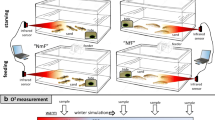Abstract
The winkle Littorina littorea (L.) feeds mainly when moistened by the tide and is quiescent when exposed to the drying effects of the wind and sun. Upper shore winkles thus experience a reduced feeding time compared with individuals living lower in the intertidal zone, but are able to completely compensate by an increased rate of radular activity when immersed. The rate of radular activity is influenced by the body size of winkles, by experimental temperature and by acclimation temperature, but is mainly modified by the duration of exposure to air which directly controls the rate of radular activity on immersion.
Similar content being viewed by others
Literature cited
Cornelius, P. F. S.: Activity of intertidal animals in relation to position on the shore. Ph. D. thesis, University of London 1968.
Hemmingsen, A. M.: The relation of standard (basal) energy metabolism to total fresh weight of living organisms. Rep. Steno meml Hosp. 4, 7–58 (1950).
—: Energy metabolism as related to body size and respiratory surfaces and its evolution. Rep. Steno meml Hosp. 9, 7–110 (1960).
Jørgensen, C. B.: Efficiency of particle retention and rate of water transport in undisturbed lamellibranchs. J. Cons. perm. int. Explor. Mer. 26, 94–116 (1960).
—: The biology of suspension feeding, 357 pp. Oxford: Pergamon Press 1966.
Morton, J. E., A. D. Boney and E. D. S. Corner: The adaptations of Lasaea rubra (Montagu), a small intertidal lamellibranch. J. mar. biol. Ass. U. K. 36, 383–405 (1957).
Newell, G. E.: The behaviour of Littorina littorea (L.) under natural conditions and its relation to position on the shore. J. mar. biol. Ass. U. K. 37, 229–239 (1958a).
—: An experimental analysis of the behaviour of Littorina littorea (L.) under natural conditions and in the laboratory. J. mar. biol. Ass. U. K. 37, 241–266 (1958b).
Newell, R. C. and H. R. Northcroft: The relationship between cirral activity and oxygen uptake in Balanus bananoides. J. mar. biol. Ass. U. K. 45, 387–403 (1965).
Segal, E., K. P. Rao and T. W. James: Rate of activity as a function of intertidal height within populations of some littoral molluscs. Nature, Lond. 172, 1108–1109 (1953).
Southward, A. J.: The relationship between temperature and rhythmic cirral activity in some Cirripedia considered in connection with their geographic distribution. Helgoländer wiss. Meeresunters. 10, 391–403 (1964).
Zeuthen, E.: Body size and metabolic rate in the animal kingdom. C. r. Trav. Lab. Carlsberg (Sér. chim.) 26, 15–161 (1947).
—: Oxygen uptake as related to body size in organisms. Q. Rev. Biol. 28, 1–12 (1953).
Author information
Authors and Affiliations
Additional information
Communicated by J. H. S. Blaxter, Oban
Rights and permissions
About this article
Cite this article
Newell, R.C., Pye, V.I. & Ahsanullah, M. Factors affecting the feeding rate of the winkle Littorina littorea . Marine Biology 9, 138–144 (1971). https://doi.org/10.1007/BF00348252
Accepted:
Issue Date:
DOI: https://doi.org/10.1007/BF00348252



